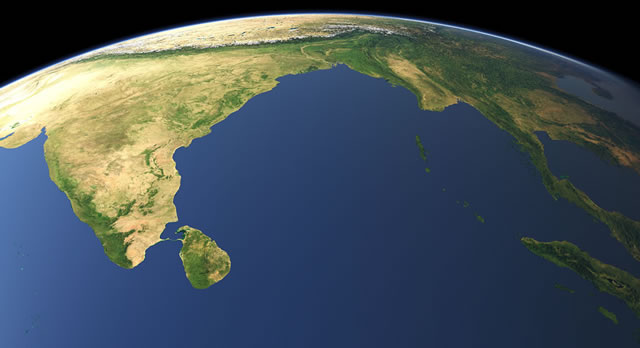
Sri Lanka
Geography
The island of Sri Lanka is located in the Indian Ocean, about 400 miles (645 kilometers) north of the equator. It is separated from the Indian subcontinent by the Gulf of Mannar and the Palk Strait. Millions of years ago Sri Lanka and India were bridged by a strip of land, remnants of which are still visible.
The" pear-shaped" island of Sri Lanka is 272 miles (438 km) long and 140 miles (225 km) wide at its broadest point. Largely flat and rolling, the terrain is distinguished by a cluster of mountain peaks, the highest of which is the 8,281-foot- (2,524-metre) high Pidurutalagala in the south-central region of the country.
Numerous rivers originate in the mountains and flow in all directions toward the sea.
The surface drainage of Sri Lanka is made up of about 100 rivers, most of which are mere wet-season rivulets. Twelve major rivers account for about 75 percent of the mean annual river discharge of the country, with those that flow entirely through the Wet Zone (the highlands and the southwestern part of the country; see below) carrying about half the total discharge. With the exception of the 208-mile-long Mahaweli River, all major rivers flow radially from the Central Highlands to the sea. The Mahaweli, which originates on the western slopes of the highest areas of the highlands, follows a circuitous route in its upper reaches before it enters the plain to the east of the highlands and then flows toward the northeast coast. Because a part of its catchments is well within the Wet Zone, this river has a larger and less seasonally varied flow than the other Dry Zone rivers and so is a major asset for irrigation in the drier parts of the country.
Space images taken by NASA reveal this mysterious ancient bridge in the Palk Strait between India and Sri Lanka. The bridge currently named as Adam's Bridge is made of a chain of limestone shoals, circa.18 miles (30 km) long.
Geologically, the island of Sri Lanka is considered a southerly extension of peninsular India (the Deccan), with which it shares a continental shelf and some of its basic lithologic and geomorphic characteristics.
Hard, crystalline rock formations, such as granite, gneisses, khondalite (a type of metamorphic rock), and quartzite, make up about nine-tenths of the island's surface and subsurface.
To look for selected Sri Lanka hotels or guesthouses click here...
For more travel and background information on Sri Lanka, read our Sri Lanka Guide and the travel tips, helping you to make the most out of your holiday in Sri Lanka.

